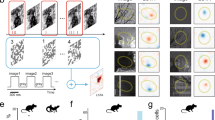Abstract
Simple cells have often been characterised as edge detectors. This paper proposes a specific neural wiring for simple cells that operate as optimal edge detectors. The proposed simple cell is also selective for the edge contrast. Responses of this model simple cell to edges, bars, sinusoids, and flashed lights are simulated and are similar to real nondirectional simple cell responses.
Similar content being viewed by others
References
Atick JJ, Redlich AN (1990) Mathematical models of the simple cells in the visual cortex. Biol Cybern 63:99–110
Campbell FW, Cooper GF, Enroth-Cugell C (1969) The spatial selectivity of the visual cells of the cat. J Physiol 203:223–235
Canny JF (1986) A computational approach to edge detection. IEEE Trans Pattern Anal Mach Intell 8:679–698
Derrington AM, Lennie P (1984) Spatial and temporal contrast sensitivities of neurones in lateral geniculate nucleus of macaque. J Physiol 357:219–240
De Valois RL, Albrecht DG, Thorell LG (1982) Spatial frequency selectivity of cells in macaque visual cortex. Vision Res 22:545–559
Drasdo N (1989) Receptive field densities of the ganglion cells of the human retina. Vision Res 29:985–988
Edelman S, Poggio T (1989) Integrating visual cues for object recognition. Opt News 15:8
Ferster D, Koch C (1987) Neuronal connections underlying orientation selectivity in cat visual cortex. Trends Neurosci 10:487–492
Gamble EB, Poggio T (1987) Visual integration and detection of discontinuities: the key role of intensity edges. MIT AI Memo 970
Glezer VD, Yakovlev VV, Gauzelman VE (1989) Harmonic basis functions for spatial coding in the cat striate cortex. Vis Neurosci 3:351–363
Grimson WEL (1981) From images to surfaces. MIT Press, Cambridge Mass
Heggelund P (1981) Receptive field organisation of simple cells in cat striate cortex. Exp Brain Res 42:89–98
Heggelund P (1985) Receptive field organisation of simple and complex cells. In: Rose D, Dobson VG (eds) Models of the visual cortex. Wiley, New York, pp 358–365
Henry GH (1985) Design duplication in streams of the striate cortex. In: Rose D, Dobson VG (eds) Models of the visual cortex. Wiley, New York, pp 351–357
Hildreth E (1984) The measurement of visual motion. MIT Press, Cambridge Mass
Hubel DH, Weisel T (1962) Receptive fields, binocular interactions, and functional architecture in the cat's visual cortex. J Physiol (Lond) 160:106–154
Hubel DH, Weisel T (1968) Receptive fields and functional architecture of monkey striate cortex. J Physiol (Lond) 195:215–243
James AC (1991) Nonlinear operator network models of processing in the fly lamina. In: Pinter R, Nabel V (eds) Nonlinear vision. CRC Press, New York
Koch C, Poggio T (1985) The synaptic veto mechanism: does it underlie direction and orientation selectivity in the visual cortex? In: Rose D, Dobson VG (eds) Models of the visual cortex. Wiley, New York, pp 408–419
Kulikowski JJ, Bishop PO (1981) Fourier analysis and spatial representation in the visual cortex. Experientia 37:37–68
Luenberger DG (1984) Linear and Nonlinear Programming, 2nd edn. Addison-Wesley, Reading Mass
Marcelja S (1980) Mathematical description of the responses of simple cells. J Opt Soc Am 70:1297–1300
Marr D (1982) Vision. Freeman, San Fransisco
Marr D, Hildreth E (1980) Theory of edge detection. Proc R Soc Lond [Biol] 207:187–217
Marr D, Ullman S (1981) Directional selectivity and its use in early visual processing. Proc R Soc Lond [Biol] 211:151–180
Pollen DA, Ronner SF (1982) Spatial computation performed by simple and complex cells in the visual cortex of the cat. Vision Res 22:101–118
Richter J, Ullman S (1982) A model for the temporal organisation of X- and Y-type receptive fields in the primate retina. Biol Cybern 43:127–145
Richter J, Ullman S (1986a) Nonlinearities in cortical simple cells and the possible detection of zero-crossings. Biol Cybern 53:195–202
Richter J, Ullman S (1986b) Are nondirectional simple cells constructed from directional subunits? Biol Cybern 54:313–317
Ruff PI, Rauschecker JP, Palm G (1987) A model of direction-selective “simple” cells in the visual cortex based on inhibition asymmetry. Biol Cybern 57:147–157
Sakai HM, Naka K-I, Korneberg MJ (1988) White-noise analysis in visual neuroscience. Vis Neurosci 1:287–296
Schiller PH, Findlay BL, Volman SF (1976) Quantitative studies of single cell properties in monkey striate cortex I. Spatiotemporal organisation of receptive fields. J Neurophysiol 39:1288–1319
Shapley R, Perry VH (1986) Cat and monkey retinal ganglion cells and their visual functional roles. Trends Neurosci 95:229–235
Sillito AM, Kemp JA, Milson JA, Berardi N (1980) A re-evaluation of the mechanisms underlying simple cell orientation selectivity. Brain Res 194:517–520
Williams DR (1988) Topography of foveal cone mosaic in the living human eye. Vision Res 28:433–454
Author information
Authors and Affiliations
Rights and permissions
About this article
Cite this article
McIlhagga, W. A model for simple cells as optimal edge detectors. Biol. Cybern. 66, 177–183 (1991). https://doi.org/10.1007/BF00243293
Received:
Accepted:
Issue Date:
DOI: https://doi.org/10.1007/BF00243293




